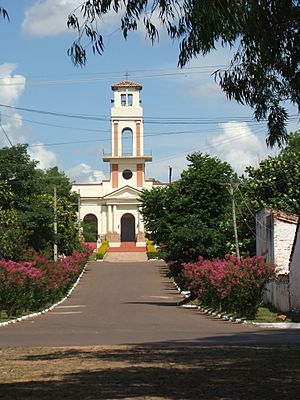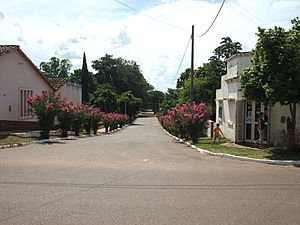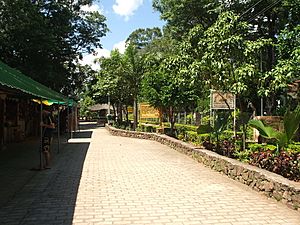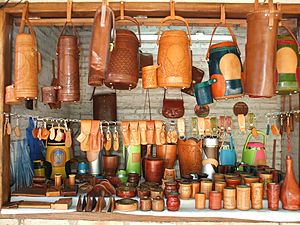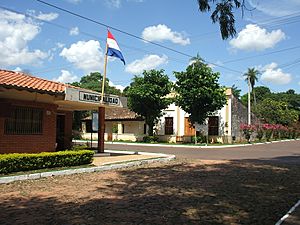Atyrá facts for kids
Quick facts for kids
Atyrá
|
|
|---|---|
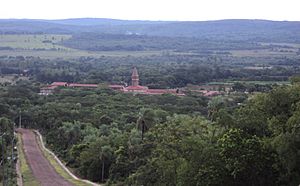
Atyrá, Paraguay
|
|
| Country | Paraguay |
| Department | Cordillera |
| Founded | October 4, 1538 |
| Elevation | 95 m (312 ft) |
| Population | |
| • Total | 15,278 |
| Time zone | UTC-04 (AST) |
| • Summer (DST) | UTC-04 (ADT) |
| Area code(s) | +595 (520) |
| Climate | Cfa |
Atyrá is one of the oldest cities in Paraguay. It is located about 61 kilometers (38 miles) east of Asunción, the country's capital. Atyrá is part of the Cordillera Department in central Paraguay.
Contents
Discovering Atyrá's History
Atyrá was first named Atyhá. It was founded by Governor Domingo Martínez de Irala in 1538. The name "Atyhá" comes from the Guarani language. It means a "meeting place," because it used to be a Guaraní village where people gathered.
In 1580, Franciscan missionaries, led by Alonso de San Buenaventura and Fray Luis de Bolaños, helped establish the religious foundations of several towns, including Atyrá.
The Church of Atyrá
The Church of Atyrá is now a museum of sacred art. It displays beautiful wooden carvings made by local people since 1580. These carvings show a unique Baroque style that mixes Spanish and Guaraní art.
Building the church began around 1782. Father Almada encouraged its construction and also helped the people of Atyrá develop their crafting skills.
The church was updated in 1852 by order of the President of Paraguay, Carlos Antonio López. The building you see today was completed in 1928.
Historically, the town grew around the church, which was common for many Paraguayan towns. The church is not in the very center of the city. Instead, it stands at what looks like the beginning or end of an avenue. Inside, you can still see the original altar from the 18th century. It also has statues of important religious figures like the Virgin of Sorrows and Saint Francis, all created under the guidance of the Franciscan missionaries.
Exploring Atyrá's Geography
Atyrá is located in the Altos Cordillera region. The city's landscape features many large rocks that form rolling hills.
Atyrá shares borders with several other towns:
- To the north: Arroyos y Esteros
- To the northeast: Loma Grande District
- To the south: Tobatí
- To the west: Altos
- To the southeast: San Bernardino and Ypacarai
Atyrá's Climate
The weather in Atyrá is mild and dry. The average temperature is about 22°C (72°F). In summer, temperatures can reach 39°C (102°F). In winter, they can drop to 3°C (37°F).
People and Population
Atyrá has a population of about 15,278 people. This includes 8,004 men and 7,274 women, based on 2008 estimates. The population density is about 70 people per square kilometer.
Neighborhoods and Rural Areas
Most homes in Atyrá are modern. However, some houses from the 19th century still stand. These older homes show the traditional architecture of the Colonial period. Some even have hay roofs and are surrounded by local trees and palm trees.
The city is divided into two main parts: an urban area and a rural area.
Urban Neighborhoods
The neighborhoods in the urban area are:
- San Antonio
- San Blás
- Las Mercedes
- María Auxiliadora
Rural Localities
The rural areas include these localities:
- Candia
- San Vicente
- Gral. Bernardino Caballero
- Zanja hú
- Comandante Ojeda
- Caacupemí
- Tacuaty
- Mbururú
- Candia Loma
- Catumbey
- Cauguá
- Potrero
- Monte Alto
Atyrá's Economy
The people of Atyrá mostly work in agriculture and cattle farming. The city also has factories that produce coconut oil and sawmills.
Many residents continue the traditional artisan crafts from the Colonial period, especially making items from leather, like saddles.
Arts and Culture
Atyrá is famous for its beautiful artisan work in leather and fabric. Local artisans also create many objects from wood. Their handmade products are sold at a permanent market in the city center.
The city celebrates the religious holiday of Saint Francis of Assisi, its patron saint, every year on October 4.
Traditional Stories
A well-known story from Paraguayan folklore comes from Atyrá. It's the tale of Indio José. During a big storm, he was trapped and prayed to the Virgin of the Immaculate Conception for help. He miraculously found a tree to climb on Zanja Hú Hill, which saved his life. Indio José had promised the Virgin he would carve a statue for her. That same statue is now part of the altar in the Caacupé Basilica, a major religious site in Paraguay.
Artisan Craftsmanship
Wood carving is the second most important economic activity in Atyrá. This craft began during the colonial period, taught by the Franciscan missionaries. Common themes for wood carvings include saints, legendary creatures, animals, and more.
Many families also work with leather, making items like bags, backpacks, shoes, belts, and saddles.
Tourism in Atyrá
Atyrá has a "Casa de la Cultura" (House of Culture). Here, visitors can see the amazing work created by the city's artisans.
The area around Atyrá, especially Zanja Hú, is rich in diverse plants and animals. It also has several streams perfect for swimming and water sports. The name Carumbey means "Turtle’s stream."
Buildings of Historical Value
- Atyrá’s Church still has its original Franciscan altar.
- The Saint Francis Museum has a permanent display of old photographs, historical objects, and local crafts.
A Clean and Green Municipality
Atyrá is known as the "Cleanest city of Paraguay." It has also been recognized as the seventh-most clean city in America and the eighth-healthiest community in the world by the World Health Organization. A government decree also declared it the "Ecological Capital of Paraguay." This recognition came after the city government started a program to protect the environment and encourage ecological preservation among its residents.
See also
 In Spanish: Atyrá para niños
In Spanish: Atyrá para niños



